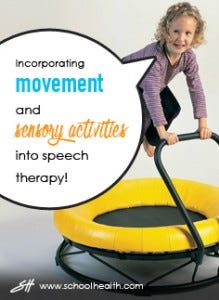Incorporating Movement and Sensory Activities into Speech Therapy
- Nov 13, 2018
- 0 Comments
 by Andrea Simpson, MS, CCC-A/SLP
by Andrea Simpson, MS, CCC-A/SLPThe prevalence of Autism continues to increase in our society. The diagnosis of educational autism also continues to increase within the schools. As current school speech caseloads are high, many children on the Autism “spectrum” make up a majority of a speech therapists’ caseload. It is important for speech therapists to constantly network with their occupational therapist when working with children with Autism in the school setting. In order to maximize time during speech and language sessions, it is often necessary to utilize a variety of sensory techniques during speech treatment. Quite often, the occupational therapist is the speech therapists best friend. These ideas are useful for all types of children because movement makes learning fun. Here are some useful ideas that incorporate sensory activities and movement into speech therapy.
Use of a scooter board - When using the scooter board the speech therapist can have pictures of curricular vocabulary placed up and down the hallway. The child can then scoot to pick up the pictures. Often, use of a magnetic fishing pole and buckets placed randomly in the hallway make this activity engaging for the child. For additional fine motor, the child could use tweezers to pick up objects.
Use of a swing - When working on object to picture matching a swing can be helpful to maintain joint attention with a child. Giving the child the object to hold while swinging and then holding up two or more picture choices and allowing them to cross midline to reach and chose the correct picture for the object.
Use of a weighted vest - When using a weighted vest you can tape up pictures up and down the stairs. To incorporate heavy work, have the child wear the weighted vest to climb stairs and identify/match /say pictures. Also, using pinchers to pick up objects or pictures and carry them up the stairs to buckets is fun.
Use of an obstacle course - When using the obstacle course before seat work a child can often sit and maintain attention to the task for a longer period of time. We use classroom chairs for children to climb under, carpet squares (or colored spots) for jumping and tunnels for crawling. A mini-trampoline can also be used and well as a rocking chair. When these activities are used prior to speech therapy, often a child is more vocal and more engaged.
 Use of bitty bottoms for seated work - When using a “wiggly” bitty bottom during speech a child often can keep from having to stand up and avoid the task. Some children need the extra “wiggle” to learn and stay focused.
Use of bitty bottoms for seated work - When using a “wiggly” bitty bottom during speech a child often can keep from having to stand up and avoid the task. Some children need the extra “wiggle” to learn and stay focused.Use of a wagon or sled –Using a wagon or a sled works best with a small group of two children. One child pulls the wagon and the other child sits in the wagon and describes where to find the objects and pictures. Often this is used for work on prepositional concepts and having one child tell the other where to find pictures and objects (over, under, in, behind, above, etc.). Many children benefit from heavy pulling and movement during speech. When incorporating a third child, have that child push the wagon from behind.
Uses of a trampoline - When performing this activity do not just allow the child to jump like crazy. Have the child sing the ABC’s or other classroom songs, count or label pictures. Often, getting the child moving before entering the speech room helps maintain focus and attention to task.
Use of aspects of the drive-thru menu to maintain focus during speech- If a child is off task and having trouble focusing, often a few quick wall push-ups, jumping jacks, or sit-ups can do the trick and bring the child back to the table to continue their seat work.
Using movement and sensory activities keeps children engaged. These activities are fun and take the pressure off of “talking”. To maximize progress toward IEP speech goals, now is the time to share ideas and develop a strong professional relationship with your school occupational therapist. An occupational therapist makes for a good treatment partner and best friend.
For more sensory and movement products, shop our Sensory and Motor Skills categories.
